Wrestling with loading it by myself for the first time and its maiden voyage
A couple of weeks ago, I purchased a fiery red Inuit LiquidLogic 14.5 kayak I saw listed on Craigslist. 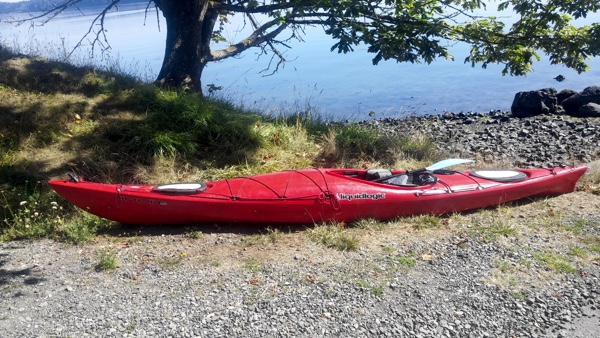 I met the seller in the pouring rain just south of Yelm. I inspected it pretty carefully, and it looked good, despite having been stored outside without protection. The hull had very few scratches, unlike my beloved Dragonfly, which has been dragged through rocks and parking lots. It has three storage compartments, a rudder, and the low seatback that I need. And, it fit me well. For $400, it seemed like a good deal, especially since these are around $1000 new. He helped me load it on my Sport Trac, and I headed home.
I met the seller in the pouring rain just south of Yelm. I inspected it pretty carefully, and it looked good, despite having been stored outside without protection. The hull had very few scratches, unlike my beloved Dragonfly, which has been dragged through rocks and parking lots. It has three storage compartments, a rudder, and the low seatback that I need. And, it fit me well. For $400, it seemed like a good deal, especially since these are around $1000 new. He helped me load it on my Sport Trac, and I headed home.
Today was my first opportunity to use it. I got it down off my kayak rack and scrubbed it on my front lawn. The rubber covers kept the storage compartments pretty clean, but the cockpit had some growth in it, probably from collecting rainwater. But, it cleaned up easily enough. The rudder had been removed and was in one of the storage compartments. The seller told me he had done that to protect it during storage.
It turns out that wasn’t quite true.
Surprise!
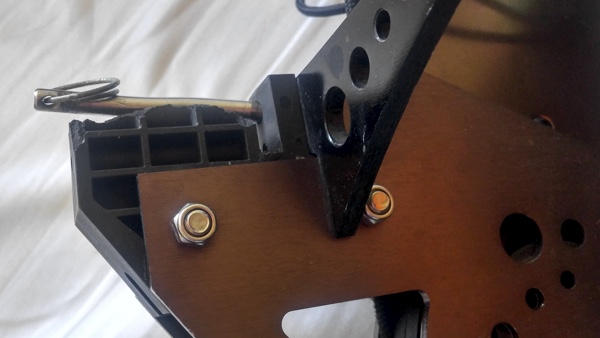 On closer inspection, the rudder is actually broken at the connecting pin. Bloody hell! No wonder it seemed like a good deal! I should have looked more closely, and I should have asked the seller to put the rudder back on it so I could test it before I purchased it.
On closer inspection, the rudder is actually broken at the connecting pin. Bloody hell! No wonder it seemed like a good deal! I should have looked more closely, and I should have asked the seller to put the rudder back on it so I could test it before I purchased it.
Did I mention it was pouring down rain? Absolutely blinding buckets of rain. I had let the weather and my excitement cloud my judgment.
Live and learn! This is going to be yet another expensive lesson for me, and it will be a good one. I am going to learn how to figure out what kind of rudder I need, select one, and then install it. When I am done, I will be very familiar with rudders. And, if mine breaks or malfunctions while on a trip, I will know how to deal with it.
In the meantime, I can still use this on lakes and other protected environments. Rudders are optional on this model, so it should be just fine.
I finished cleaning it and let it dry in the sun for a bit while I tackled Dragonfly. I’m usually pretty good about cleaning it out after each use, but I have very limited space in the RV park. After I got home from my weekend at Millersylvania State Park in June, I had simply loaded it up on my kayak rack. But, it wasn’t too bad. A quick rinse, and it went back on the rack.
Now for the fun part: Loading the 65-pound Inuit kayak on top of my Sport Trac by myself. I never loaded Dragonfly on the roof; it is small enough that I just put it in the bed of my truck. However, I had YouTubed how to do this, so I had a pretty good idea. I moved Big Red out of the way so I had plenty of room to maneuver the kayak, and then draped my hot pink fuzzy bathroom rug over the side of the truck and the cargo rack side rail.
Have I mentioned the Inuit kayak is 65 pounds? Dragonfly’s 35 pounds seem ridiculously light by comparison. I can’t carry the Inuit; it’s just too heavy. I have to drag it.
I leaned the front end on the side of the Sport Trac and tried to slide it into the J-cradle, but the kayak kept trying to turn right-side up. I tried so slide it further up and then in, and it still fought me. 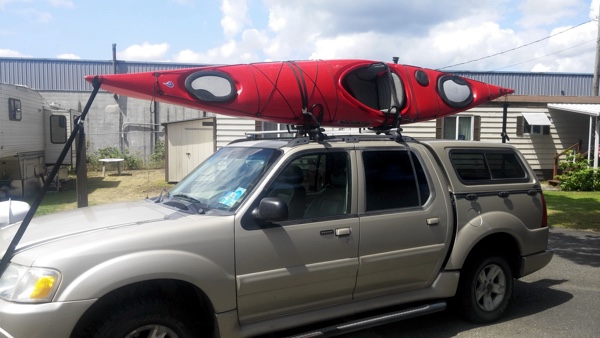 Finally, I lifted it over my head, and that worked! It was hard, though. And not just because it’s heavy. As I lifted it, it turned upside down and slid upwards onto the cradle, catching the end of the cradle in the cockpit. But once I lifted the back end, I could twist it enough to slide it gently in. Woohoo!
Finally, I lifted it over my head, and that worked! It was hard, though. And not just because it’s heavy. As I lifted it, it turned upside down and slid upwards onto the cradle, catching the end of the cradle in the cockpit. But once I lifted the back end, I could twist it enough to slide it gently in. Woohoo!
I secured it with two straps on the side and one on each end, grabbed my gear, and I was ready to go.
I had originally planned to go to the Nisqually boat launch and test it in the Sound, but it was low tide and I felt a little unsure of myself. I’ve never kayaked in the Sound before. Hell, I’ve never kayaked on anything but lakes, so it was probably best to stick to that for the first time out. I headed out to the Long Lake boat launch, instead.
Unloading the Inuit was almost as awkward as loading it, but I managed. In no time, it was in the water and ready to go.
It is a lot narrower than Dragonfly and a lot less stable. I have kayaked twice in REI’s Wilderness Systems 17′ kayaks, and I don’t remember any stability issues. But, all kayaks are different, so this will just take some getting used to.
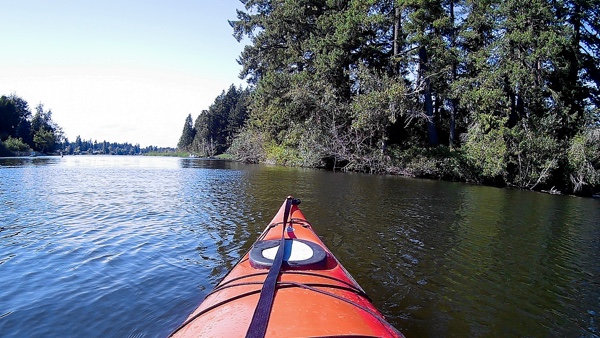 It also isn’t as fast as the Wilderness Systems kayaks, and that’s OK. I bought this as an entry-level kayak to use on local lakes and protected areas of South Puget Sound. I am not going to use it in the San Juans or on any trips where speed might be an issue.
It also isn’t as fast as the Wilderness Systems kayaks, and that’s OK. I bought this as an entry-level kayak to use on local lakes and protected areas of South Puget Sound. I am not going to use it in the San Juans or on any trips where speed might be an issue.
However, the tracking is off. Waaaayyyyyyyy off.
It needs that rudder. I spent most of my time paddling on one side or the other, just trying to keep it going in a straight line. It was pretty frustrating. When I used REI’s kayaks, the rudders were up on both, and I never had any tracking issues with either. I shouldn’t have had any tracking issues with this one, either.
So, I’m not sure if this kayak is for me. I will replace the rudder and spend some time with it. 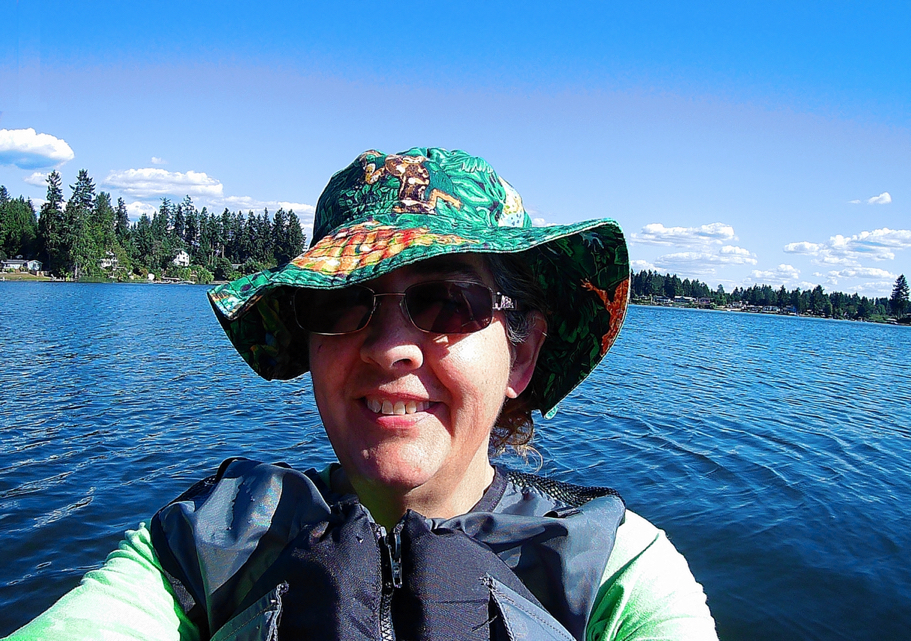 If I still don’t like it next spring, then I’ll sell it and look for something else.
If I still don’t like it next spring, then I’ll sell it and look for something else.
When loading it for the drive home, I discovered removing the back hatch cover created another handhold area where I can get a much better grip, making it a lot easier to lift. With a little more practice, I should be able to get the routine down.